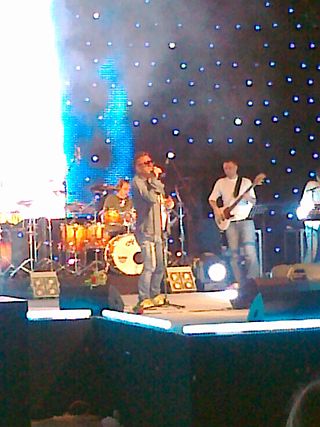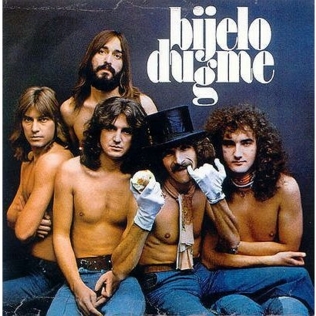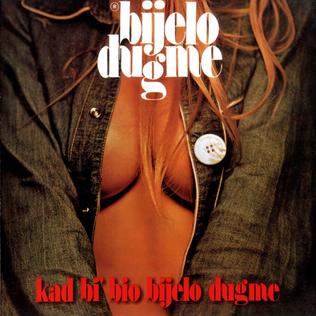
Goran Bregović is a recording artist from Bosnia and Herzegovina. He is one of the most internationally known modern musicians and composers of the Slavic-speaking countries in the Balkans, and is one of the few former Yugoslav musicians who has performed at major international venues such as Carnegie Hall, Royal Albert Hall and L'Olympia.

Želimir "Željko" Bebek is a Bosnian-Herzegovan and Croatian vocalist and musician most notable for being the lead singer of former Yugoslav rock band Bijelo Dugme from 1974 to 1984. He also has a successful career as a solo artist.

Alija "Alen" Islamović is a Bosnian rock vocalist. He is best known as the lead singer of Bosnian and Yugoslav rock bands Divlje jagode from 1979 to 1986 and Bijelo Dugme from 1986 to 1989.

Mladen Vojičić, known professionally by his nickname/stagename Tifa, is a Bosnian Serb rock vocalist. He gained acclaim throughout former Yugoslavia for his brief stint as the lead singer of Bijelo Dugme in the mid-1980s.

Bijelo Dugme was a Yugoslav rock band, formed in Sarajevo, SR Bosnia and Herzegovina in 1974. Bijelo Dugme is widely considered to have been the most popular band ever to exist in the former Socialist Federal Republic of Yugoslavia and one of the most notable acts of the Yugoslav rock scene and Yugoslav popular music in general.

Šta bi dao da si na mom mjestu is the second studio album from influential Yugoslav rock band Bijelo Dugme, released in 1975.

Eto! Baš hoću! is the third studio album by Yugoslav rock band Bijelo Dugme, released in 1976.

Bitanga i princeza is the fourth studio album by Yugoslav rock band Bijelo Dugme, released in 1979.

Doživjeti stotu is the fifth studio album by Yugoslav rock band Bijelo Dugme, released in 1980.

5. april '81 is the second live album by Yugoslav rock band Bijelo Dugme, released in 1981. It was recorded in Kulušić club in Zagreb on 5 April 1981. The album was originally put out in limited release of only 20,000 copies.

Koncert kod Hajdučke česme is the first live album by Yugoslav rock band Bijelo Dugme, released in 1977. The album's title refers to the band's famous concert played on August 28, 1977 near Hajdučka česma grounds at Košutnjak Park in Belgrade. However, the material on the record is only partially recorded at the said event.

Ćiribiribela is the ninth and final studio album by Yugoslav rock band Bijelo Dugme, released in 1988. Bijelo Dugme would split-up in 1989, and Ćirbiribela would be the band's last release before the band's 2005 reunion and the live album Turneja 2005: Sarajevo, Zagreb, Beograd.

Bijelo Dugme is the seventh studio album by Yugoslav rock band Bijelo Dugme, released in 1984. Due to Bijelo Dugme's usage of Uroš Predić's famous painting Kosovo Maiden for the album cover, the album is unofficially known as Kosovka djevojka.

Pljuni i zapjevaj moja Jugoslavijo is the eighth studio album by Yugoslav rock band Bijelo Dugme, released in 1986.

Uspavanka za Radmilu M. is the sixth studio album by the Yugoslav rock band Bijelo Dugme, released in 1983.

Kad bi' bio bijelo dugme is the 1974 debut studio album from influential Yugoslav rock band Bijelo Dugme.

Mramor, kamen i željezo is the third live album by Yugoslav rock band Bijelo Dugme, released in 1987. Originally released as a double album, the material was recorded throughout 1987 during the band's tour in support of their Pljuni i zapjevaj moja Jugoslavijo album.

Lazar "Laza" Ristovski was a Serbian and former Yugoslav keyboardist, known for being a member of rock bands Smak and Bijelo Dugme, as well as for his eclectic solo work that spanned many different musical genres.

Singl ploče (1976–1980) is a compilation album by Yugoslav rock band Bijelo Dugme, released in 1982.

...a milicija trenira strogoću! is a children's music album recorded by Yugoslav child singer Ratimir Boršić "Rača" and Yugoslav rock band Bijelo Dugme, released in 1983.





















